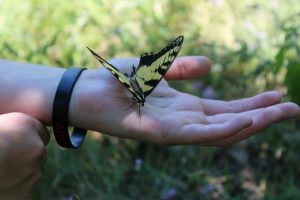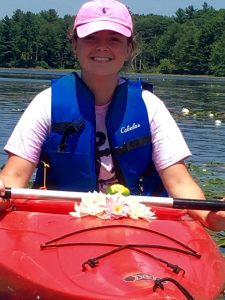- This week was very exciting. Everything we did was not only physically exhausting but also breathtakingly beautiful. Each day keeps getting more eventful. I am constantly amazed at how much there is to do around our area. I look forward to this upcoming week of testing and I am curious to see how my results play out. This course has definitely affected my summer for the better.
- This week was pretty good. The bike ride on Monday was intense but rewarding. The terrain on Moosic Mountain was really cool, and I liked learning about the controlled burns and the barrens. The Mount Minsi hike was “vigorous” in some parts but mostly enjoyable, and the history was interesting to hear. I really enjoyed chopping the Japanese knotweed, and I think I found my zombie apocalypse weapon of choice. This week sucked a little because Tara wasn’t there, but overall it was pretty good.
- The bike ride through Clarks Summit was difficult, but aside from this, all the other events this week were good. The views at Mount Minsi were exceptional, and I liked the trails at Moosic Mountain. The work at Sweeney beach was fun, as it was easy to see the direct impact of our labors on the shoreline, though given the knotweed’s shockingly fast rate of regrowth, it may have been an exercise in futility. Overall, the week provided some of the course’s best experiences to date.
- Week 3 was a lot of fun. I got to re-experience one of my greatest outdoor achievements as well as learn something new about the city I’ve lived in all my life. One of the cool things about this course is that you never know what you’re going to expect. All of the different people we meet each tell us a piece of the puzzle. Bernie McGurl helped me realize that when he made it all come together. You never really think about what’s involved in order to conserve and protect nature for enjoyment. A lot of it is taken for granted and it’s really cool to see the process and meet the people that fought for it!

Monthly Archives: July 2016
Day 12 – Service Day at Sweeney Beach on the Lackawanna River
Seeing that we attend a Jesuit university that cultivates men and women for others, this class wouldn’t be complete without a service day. For the day, we spent hours at the Lackawanna River’s Sweeney Beach trying to put a dent in the elimination of the Japanese knotweed – a highly aggressive invasive plant – that has plagued the beach.
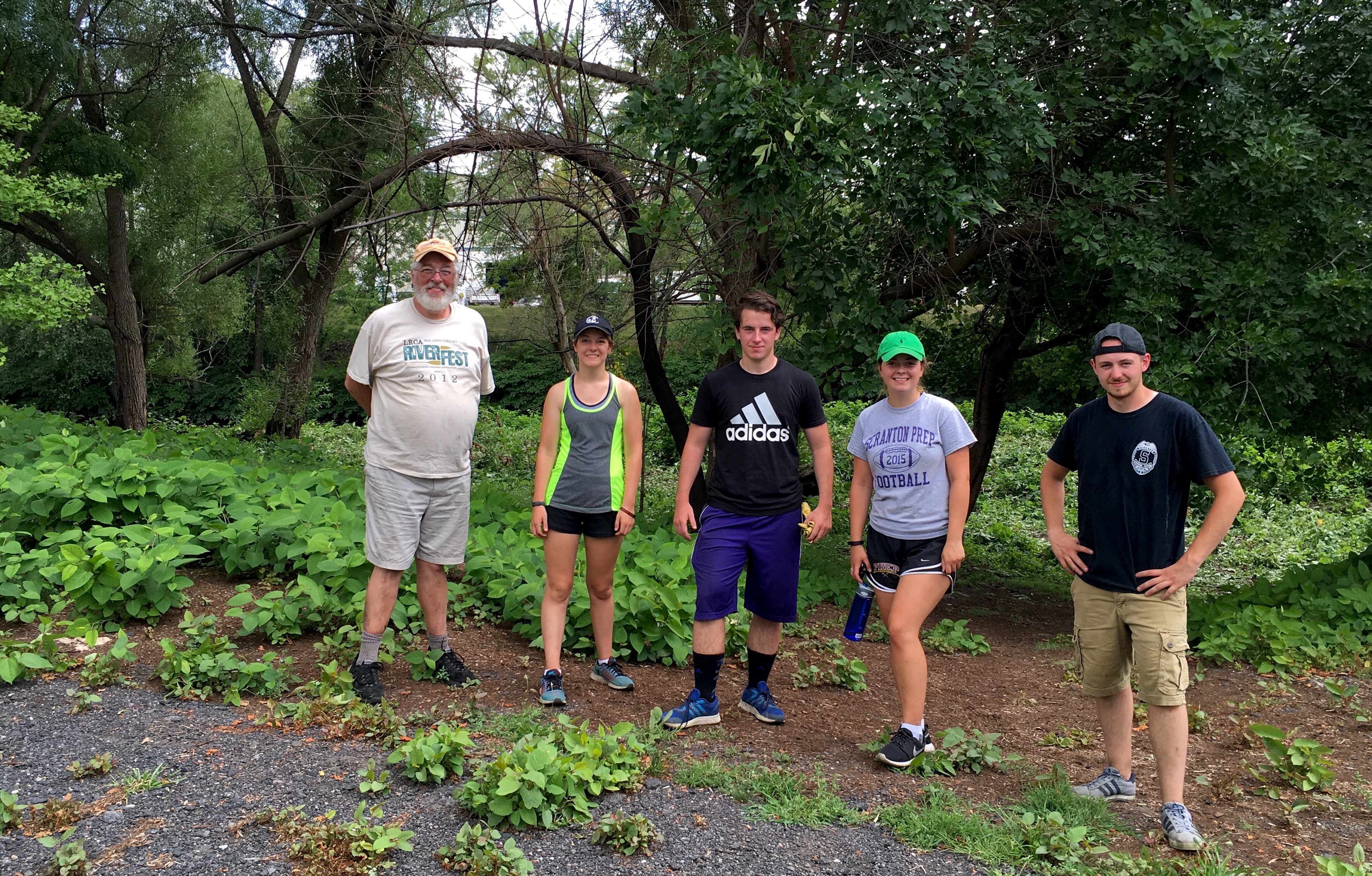
Bernie McGurl shared with us a small portion of his trove of geographic and historical knowledge on all things Lackawanna – maybe even on all things. It was interesting to hear him pull together all the different elements of local history that we had come to learn of in bits and pieces in the previous weeks, such as the Tocks Island Dam controversy that ultimately led to the creation of the Delaware Water Gap National recreation area and the prescribed fires used to reclaim the ecology of a number of local lands. He told us how Sweeney Beach was named after the Sweeney brothers paving company located nearby.
After Bernie finished – well, not quite finished – we were handed gloves, brand new machetes, and we turned toward the knotweed. We split up so that we were in no ones “blood circle” and took on the weed. We chopped, “raked”and grunted for a couple hours with a hoagie break in between. Gared almost lost a finger in the process… It was a successful day and a great way to end the last week of activity before we returned to the human performance lab.
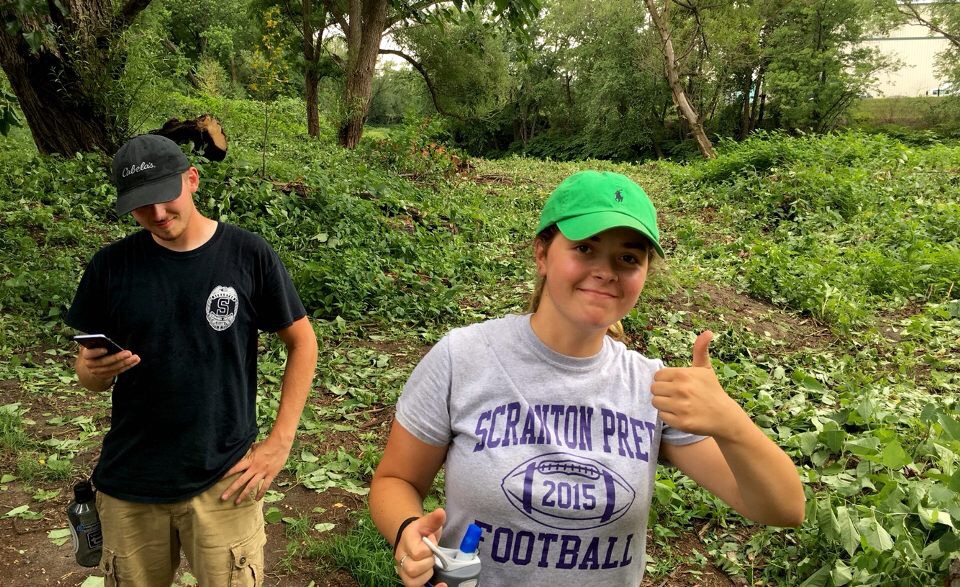
Virginia, for the EP NEPA crew…
Day 11 – Delaware Water Gap – Mt. Minsi Hike
The class presented PowerPoints on various NY Times articles on exercise in the morning. After these concluded, we drove to Mount Minsi at the Delaware Water Gap.

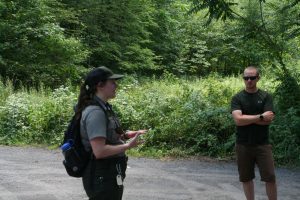 After a brief lecture from Ranger Michelle Stevens, we were to make our way up the mountain. This is Michelle’s second year at the recreation area. She is responsible for community outreach activities and some programming, and as she stressed, she spends more time behind a desk than outdoors after accepting her promotion.
After a brief lecture from Ranger Michelle Stevens, we were to make our way up the mountain. This is Michelle’s second year at the recreation area. She is responsible for community outreach activities and some programming, and as she stressed, she spends more time behind a desk than outdoors after accepting her promotion.
After a vigorous, challenging, stimulating, and eye opening, yet somehow relaxing journey up the mountain over many rocks, the class finally arrived at the peak and stopped for lunch with a beautiful view of the valley.

When Ranger Stevens made it to the top, she explained how the area was originally going to be flooded by constructing a dam. The land was seized from the residents by eminent domain, causing much tension between them and the government. Grassroots activists halted this project, and the land was converted to a federal recreation area, retaining its original natural beauty.
 Ranger Stevens asked the class to each think of one word or phrase to describe the adventure on their way back down. (All the words are contained in the first sentence of the last paragraph.) Her own word was “sweaty.” The hike covered 4.5 miles with 1100 feet of ascent. The class completed it in 2.5 hours.
Ranger Stevens asked the class to each think of one word or phrase to describe the adventure on their way back down. (All the words are contained in the first sentence of the last paragraph.) Her own word was “sweaty.” The hike covered 4.5 miles with 1100 feet of ascent. The class completed it in 2.5 hours.
Presentation of NY Times Health & Fitness Articles
Today each student presented a NY Times article that spoke to the latest understanding of health and fitness. Below you will find each student’s brief summary of the article, as well as a link to the original article…
Ryan Clarkson’s Presentation
The Fats You Don’t Need to Fear, and the Carbs That You Do
Efforts to correct past dietary sins have caused the pendulum to swing too far in the wrong direction.
JANE E. BRODY, NY Times, OCTOBER 19, 2015
This article went into detail about a false rule that many people live by and have adopted into their daily life. Jane Brody sheds light on the topic of how many people believe that a completely fat free diet is the healthiest way to live. In believing this, many people are taking in bad carbohydrates, which is very bad for you and can lead to obesity and Type II diabetes.
Fats and carbohydrates are an important part of our diet. It’s just a matter of eating the right ones. Saturated fats that you can find in junk foods are fats you should avoid. The fats you find in things like nuts and olive oil should be eaten regularly. Carbs are the same way. Certain carbs such as ones that can be found in things like white bread and baked goods aren’t good for maintaining a healthy diet. Ones that you can find in whole wheat pasta are good for you.
The article says that we need to educate people to try and break this bad habit. If we don’t, the number of people with cardiovascular diseases and poor diets will continue to rise.
Virginia Farrell’s Presentation
Lifting Lighter Weights Can Be Just as Effective as Heavy Ones
In a study, participants’ muscles got bigger and stronger whether they lifted heavy or light weights as long as they lifted until they were tired.
GRETCHEN REYNOLDS, NY Times, JULY 20, 2016
This article takes a look at the idea that working with lighter weights and heavier weights might have the same impact on muscle growth. Several tests have been performed to support this idea. Similar muscle growth was found in the people using lighter weights – who would perform more repetitions – as in the people using heavy weights – who performed fewer repetitions. Researchers found that the key to maintaining similar results was to have the subjects grow tired and attain total muscular fatigue.
However, this article does not prove that one workout regimen is better than the other. It does encourage people who would otherwise be afraid of heavier weights to start lifting lighter weights because they could expect to achieve the same results.
Gared Zaboski’s Presentation
PERSONAL BEST: Fitting Heat and Humidity Into Your Workouts
No matter how much you train in the heat, it will never be easy, athletes and researchers say.
BY GINA KOLATA, NY Times, JULY 3, 2008
This article begins with a list of commonly asked questions about exercise in the heat. These include inquiries about heat’s impact on performance times and how best to adapt to and mitigate the influence of heat on athletic events.
The author responds to these rhetorical questions by citing several studies and pieces of anecdotal evidence. The work of Dr. Cheuvront, a researcher at the Army Institute, is featured heavily. Through a study, Dr. Cheuvront found that heat does significantly and unambiguously decrease performance. He also observed several adaptations that people can make by training in hot conditions. The article states that “blood volume expands, which reduces the strain on the heart from increased blood flow to the skin and muscles.”. The article also encourages its readers to ensure they are sweating as much as possible, and it is ideal for that sweat to evaporate, as this allows the body to cool.
The article concludes by repeating the finding that heat is a negative influence on physical performance, and that athletes must “accept discomfort and slowness” despite the possibility for some adaptation to be made.
Eva Rine’s Presentation
For Athletes, the Risk of Too Much Water
Are we putting young athletes at risk when we urge them to drink lots of fluids during steamy sports practices and games?
BY GRETCHEN REYNOLDS, NY Times, AUGUST 26, 2015
Overhydration is a problem for athletes. Athletes are urged to hydrate all the time and often consume more fluid than they can get rid of, leading to hyponatremia, low blood sodium concentration. Forced to maintain the osmotic balance between the cells and the blood, cells take in water, making them swell. If this happens in the brain it can be fatal.
Often athletes will drink water or sports drinks to try to alleviate muscle cramps or to avoid heat related illnesses. They will consume gallons of fluids that their bodies cannot get rid of. This is even more harmful than dehydration. Athletes should drink water when they are thirsty and minimal amounts other times.
Day 10 – Eales Nature Preserve at Moosic Mountain – Prescribed Fires
Today (which happened to be Dr. Sweeney’s birthday!) we hiked The Dick and Nancy Eales Nature Preserve at Moosic Mountain.

Before we put on our hiking boots and hit the trails, we again discussed in the lab “what is going on in our bodies when we exercise?” Dr. Sweeney showed us several diagrams, breaking down how our bodies react to exercise. One specific diagram showed the flow distribution of blood at rest versus during moderate exercise. There were some significant changes – digestive tract blood flow reduced from 1,350 ml/min to 600 ml/min – proving that our moms were correct saying “no swimming after dinner.” The biggest shift was in the skeletal muscle. Muscle goes from 750 ml/min to 8,000 ml/min, which comes as no surprise.
We then went on to look at other diagrams, but the most impressive one we saw was made by Dr. Sweeney himself. He showed us his cardiovascular model, in which he broke down each component of the cardiovascular system into tubes, pipes and even a balloon.
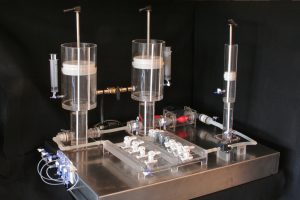
Once he explained all the different functions of the model, we began to test it. He showed us what happens with dehydration – immediately the heart ejected less blood. Along with the model, we were able to see all the functions being charted on the computer, with the ability to start and stop the heart whenever we chose.
After a couple hours in the lab we headed to Moosic Mountain. We were met by Times-Tribune reporter Kathleen Bolus and photographer Michael Mullen, who were there to help document the endeavors of the EP NEPA class. Read Kat’s story about the course here http://thetimes-tribune.com/news/extreme-physiology-nepa-edition-1.2073248.
We also met with Jenny Chase, who explained to us everything that goes on and is going on across this land. Moosic Mountain is part of The Nature Conservancy, a non-profit organization that fights to make sure natural lands and waters are conserved so that a diversity of life can continue.
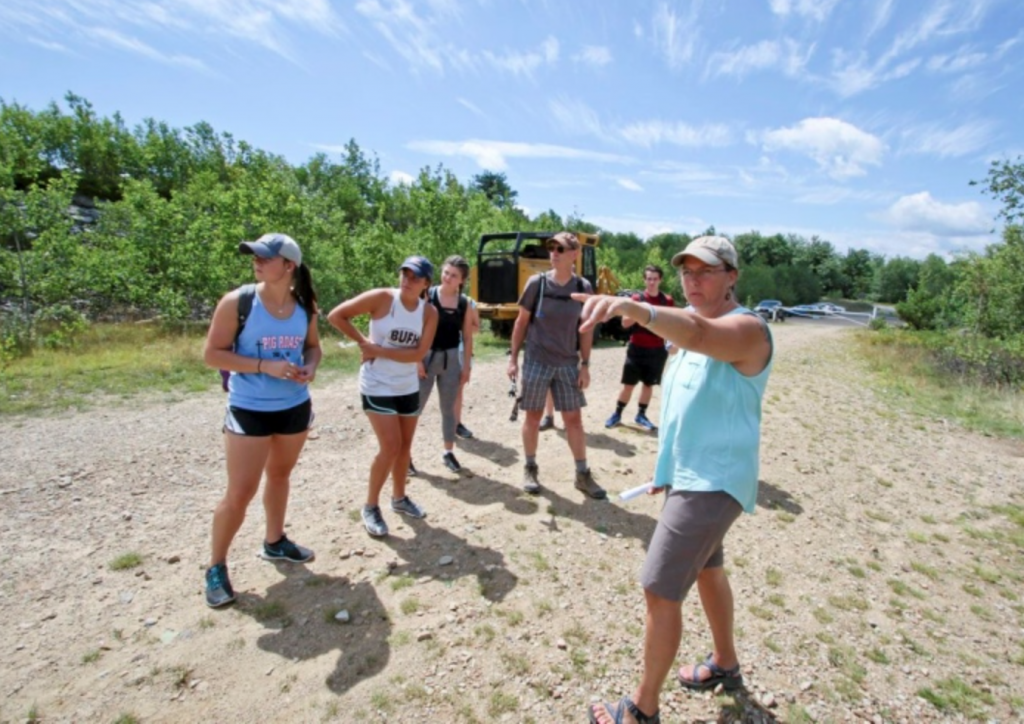
The 2,250 acre property was obtained over time. It was originally set to be made into a prison, and then into a business park, but through the Nature Conservancy’s eventual acquisition of these lands, they were able to prevent that and instead preserve this ecosystem.
The Eales Preserve has been maintaining the original nature of this ecosystem through a pattern of “prescribed fires”. These prescribed fires wipe out the more mature vegetation of the region in order to reduce the risk of wildfires, improve wildlife habitat and control weeds. The native vegetation of this “ridge-top heath barren” does well on barren soil. They begin downwind, make a circle of fuel and light it. The crews that carry out the prescribed burns are highly trained. (Don Jacobs, who documented our trip to Peck’s Pond at Delaware State Forest, has also recently produced a piece on prescribed burns, which can be viewed here http://wnep.com/2016/07/31/prescribed-burn/).
Moosic Mountain is opened to hiking and mountain biking and is maintained with the help of a number of dedicated mountain bikers.
After saying goodbye to Jenny, we hiked a couple of miles with a crew that included some Arizona Extreme Physiology alumni… the hike could’ve been shorter if we didn’t rely on Dr. Sweeney’s GPS, but it was his birthday so we let it go.
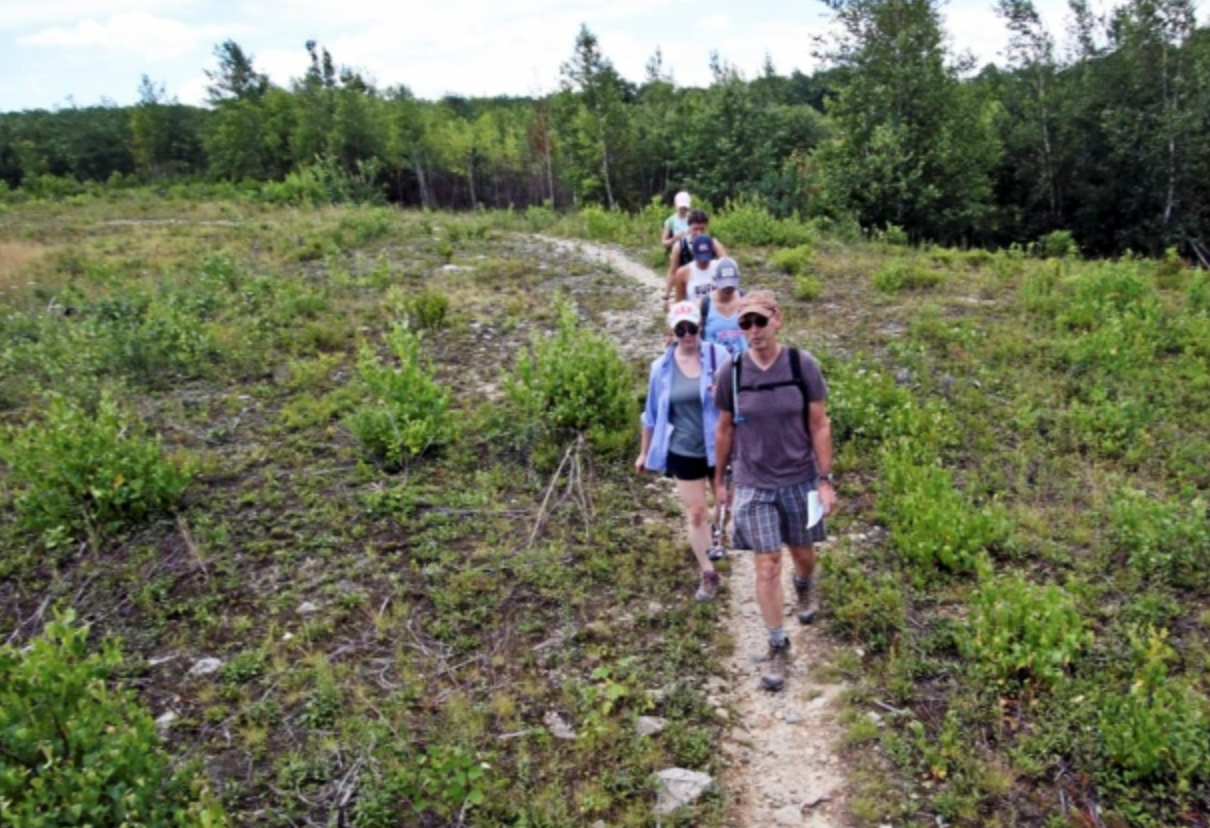
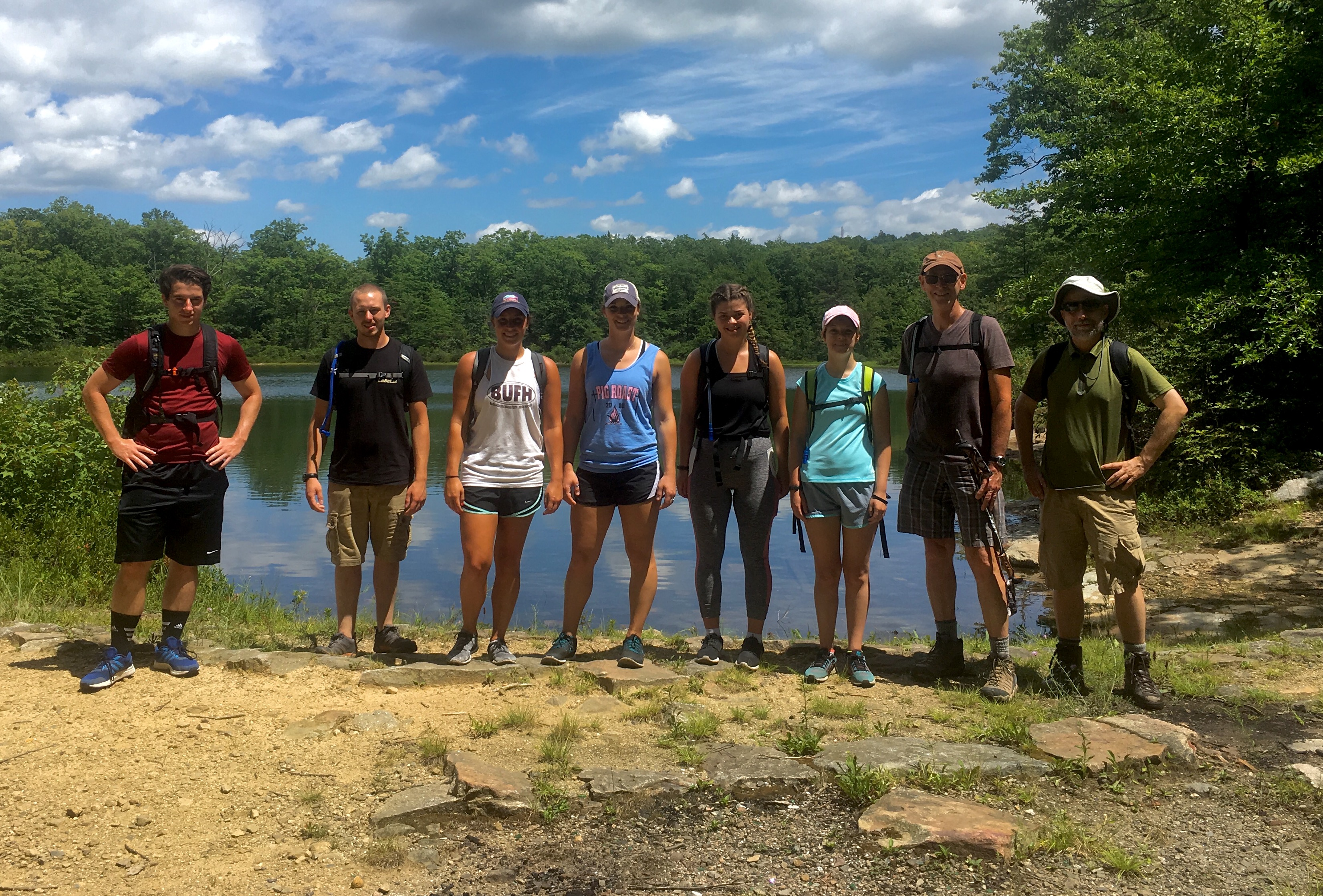
Virginia, for the EP NEPA crew…
Day 9 – Clarks Summit to Nicholson Ride; UofS Sustainability Initiatives
Today the group went on a 27 mile bike ride in the morning, from Clarks Summit to Nicholson and back again in a loop. We were met at the beginning of the ride by Times-Tribune photographer Michael Mullen, who saw the crew out on the ride.

Although the ride was shorter than last week’s ride, the hills that we had to climb certainly made it more challenging.
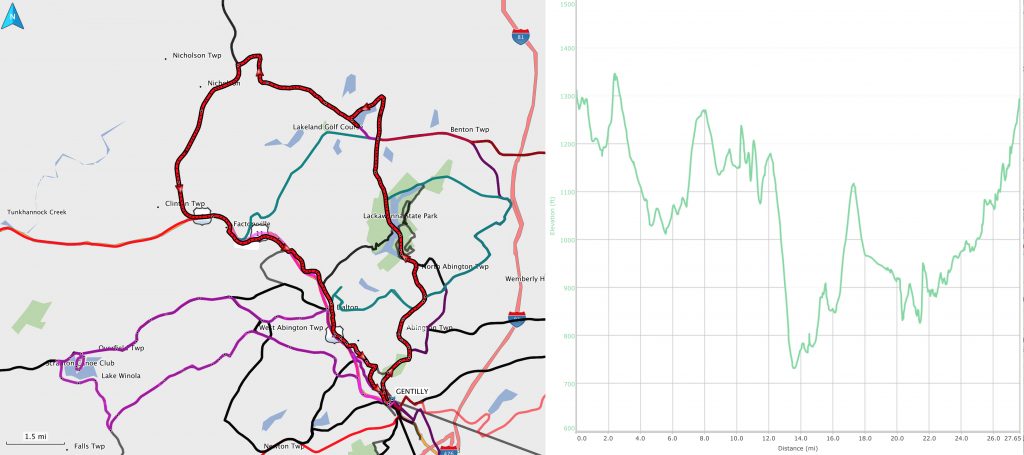 The ride covered over 2,400 feet of ascent, and gave us a spectacular view of the Nicholson Viaduct.
The ride covered over 2,400 feet of ascent, and gave us a spectacular view of the Nicholson Viaduct.
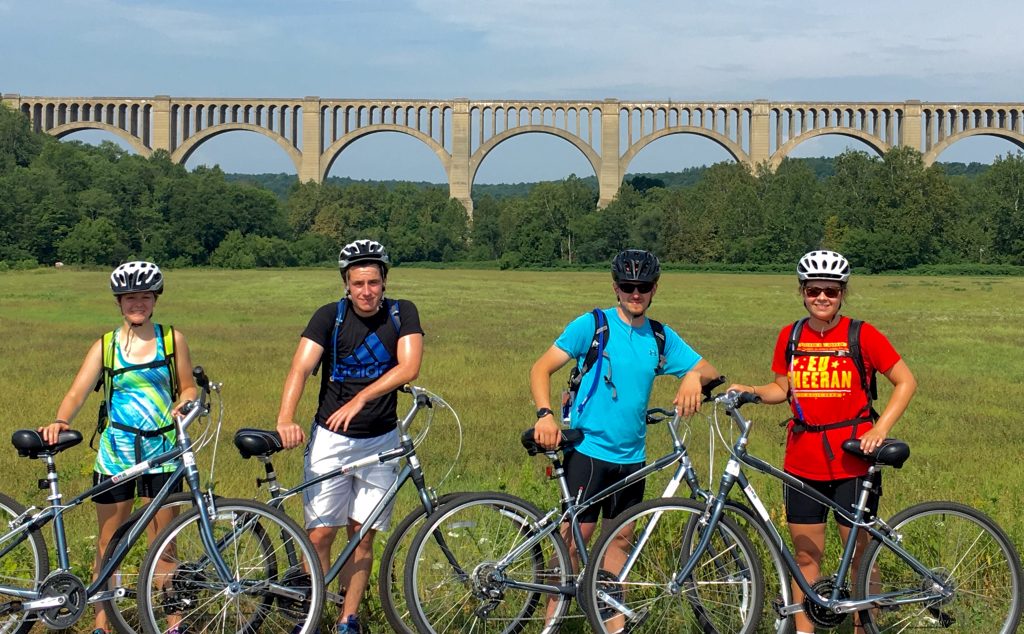 We even had an EP record – a second second breakfast stop at the Bluebird Diner.
We even had an EP record – a second second breakfast stop at the Bluebird Diner.
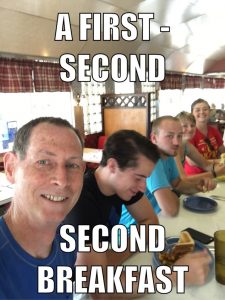 After finishing the ride and returning to campus, UofS Director of Sustainability Mark Murphy led the class on a descriptive lecture/tour of the University’s various sustainability projects. Mr. Murphy detailed the numerous steps Scranton takes to conserve resources and funds, including Solar Panels, hand dryers, LED lighting, and recycling programs. Scranton also engages in some community based sustainability activities, like the shared garden just up the road from campus.
After finishing the ride and returning to campus, UofS Director of Sustainability Mark Murphy led the class on a descriptive lecture/tour of the University’s various sustainability projects. Mr. Murphy detailed the numerous steps Scranton takes to conserve resources and funds, including Solar Panels, hand dryers, LED lighting, and recycling programs. Scranton also engages in some community based sustainability activities, like the shared garden just up the road from campus.
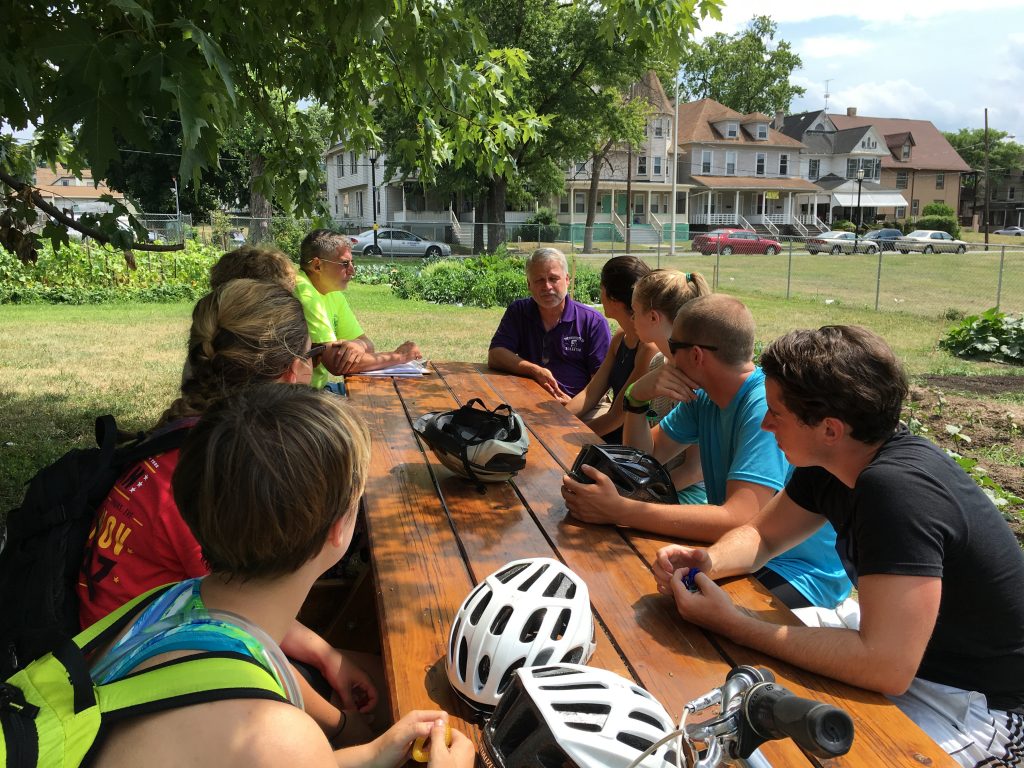 UofS Director of Sustainability Mark Murphy (back, car-right) with the class at Scranton’s Community Garden.
UofS Director of Sustainability Mark Murphy (back, car-right) with the class at Scranton’s Community Garden.
Residents are able to purchase small plots of land and take advantage of University provided resources to cultivate some crops, a portion of which are donated to a nearby food pantry. The tour was facilitated by the bike share program at the library, in collaboration with the Lackawanna Heritage Trail. This project allows bikes to be rented to both students and non students alike at no cost, encouraging the use of a low impact form of transportation.
Gared, for theEP NEPA crew…
Impressions – Week 2
- I really enjoyed Lackawanna State Park. The lecture was interesting, and I enjoyed learning a little more about our state parks. The hike was fun and Vince’s mini lectures were cool. The bike ride was awesome. I was nervous about that but it wasn’t too bad except for the hills, and then I had the pleasure of telling my family I biked 33 miles. Rickett’s Glen was fun too. I liked hiking the whole thing because the last time I was there I only hiked the falls trail. I didn’t really enjoy kayaking because of all the weeds, but I thought the fire tower was pretty cool. I would describe last week as pretty lit, as the kids say.
- Week two was filled with two of my favorite things and one of my least favorite things. I loved the hiking at Ricketts Glen State Park and the kayaking at Peck’s Pond. That 33-mile bike ride though… that was a killer. All in all, it was a very fun week. I learned that an answer someone might give as a “just give me an answer” is actually something that happens in our bodies. We actually grow more capillaries as a response to a demand in the muscles. I think that is really cool. Throughout the week I began focusing more on what my body was doing during all of our exercise. I began paying more attention to using the different muscle groups and how to monitor breathing and heart rate.
- I’ve had the most fun this week. From getting a better bike to kayaking to hiking Ricketts Glen to even white water rafting, my expectations have been exceeded. I haven’t had this much fun doing physical activity since my service trip a year ago. I don’t feel as physically challenged as I did the first week. I hope to continue doing these types of activities in the future.

A “classic” selfie after whitewater rafting with EP 2015 (Arizona) alumni - I enjoyed the hike to Rickett’s Glen. Even though it was a trail I have done countless times since my early years, its always a nice place to revisit. The trips to Lackawanna State Forest and Pecks Pond were both new to me. I preferred Lackawanna to Pecks Pond, as kayaking on a body of water infested with plant life was not as fun, despite the informative nature of the trip. The lengthy bike ride was a challenge, especially the hill leading in to Forest City, but completing that excursion proved to be rewarding.
Day 8 – Peck’s Pond in the Delaware State Forest
The class arrived at Peck’s Pond and prepared for a kayak adventure with a lecture from Tim Dugan, DCNR’s District Forester for the Delaware State Forest.
 Also accompanying us today was Don Jacobs, of WNEP’s Pennsylvania Outdoor Life, and his cameraman Brian Hollingshead, who were there to produce a segment about our course and the upcoming drawdown of Peck’s Pond.
Also accompanying us today was Don Jacobs, of WNEP’s Pennsylvania Outdoor Life, and his cameraman Brian Hollingshead, who were there to produce a segment about our course and the upcoming drawdown of Peck’s Pond.
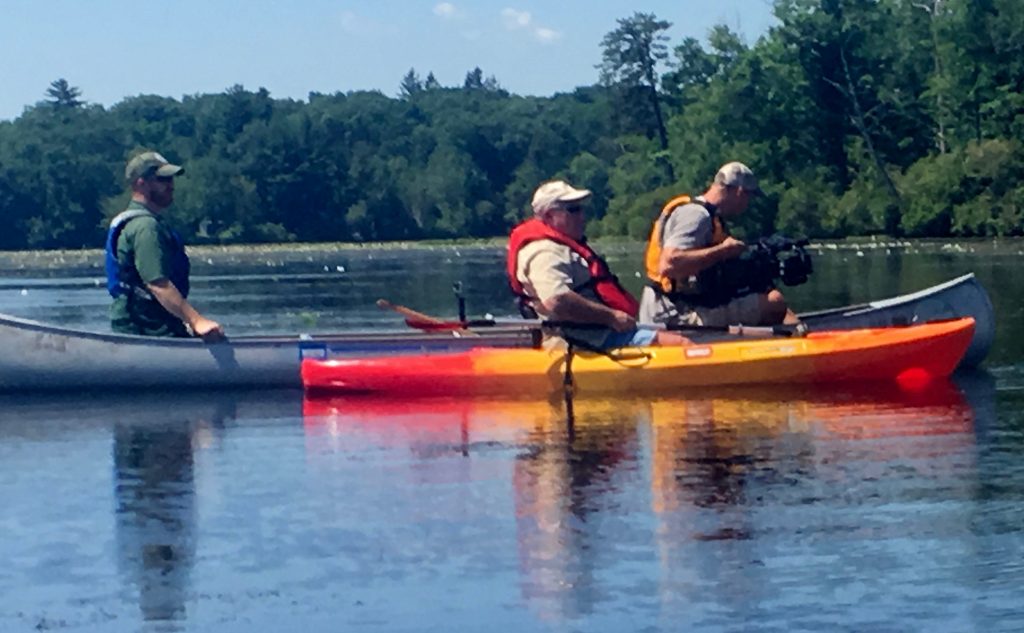
(Don’s POL segment can be viewed here: http://wnep.com/2016/07/31/university-of-scranton-extreme-physiology-at-pecks-pond/
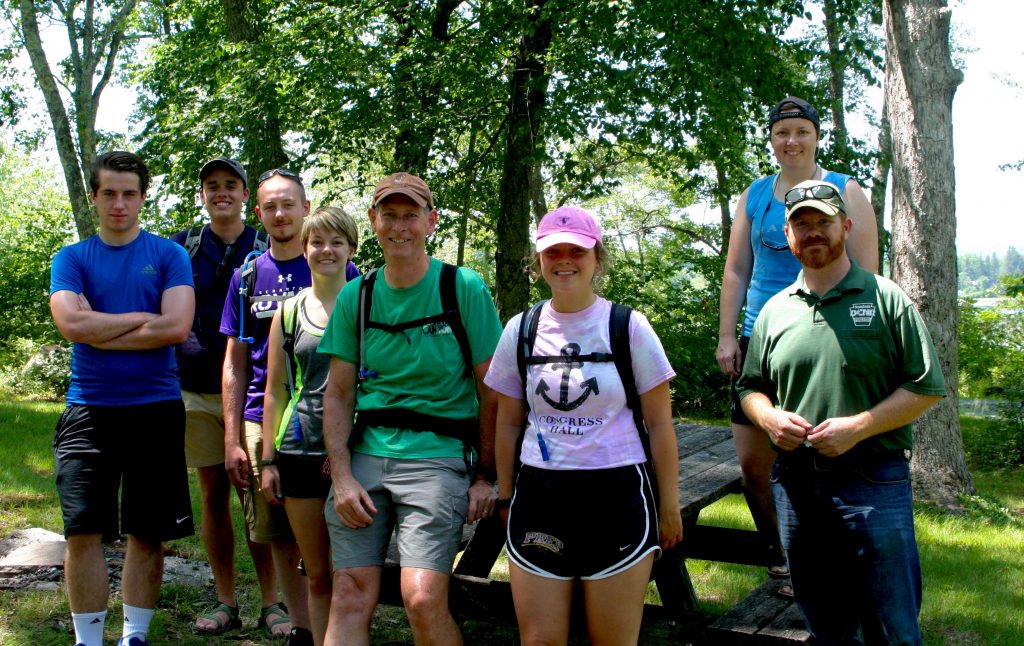
District Forrester Dugan spoke about plants that are taking over the pond such as milfoil and several species of lily pads.
There are about two meters of muck (decayed plant matter) and only one meter of water in the pond. Normally, the pond would be allowed to take its course of eutrophication (which is pond to swamp to marsh to meadow to forest,) but the residents had pressed for something to be done about the weeds, so the it will be drained. It will take about 3 weeks to drain the entire pond, and this will allow the weeds to be exposed to excessive sunlight and also be treated with herbicide before they go dormant for the winter.
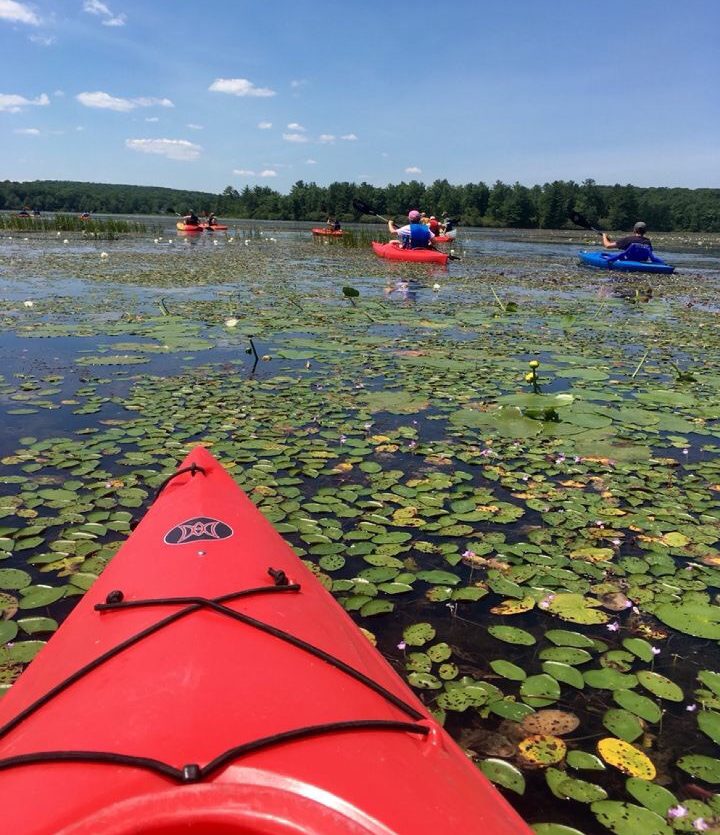
The class then kayaked for about two hours and saw the extent of the milfoil and lily pad infestation, which made it difficult to kayak.

They also saw two beaver lodges and collected various artifacts from around the lake such as flowers, a beaver stick, and a dead fish.
After kayaking, the class enjoyed lunch and then drove to the top of the mountain to see the High Knob Fire Tower. The fire tower is used to spot forest fires and help triangulate them, in conjunction with another fire tower.
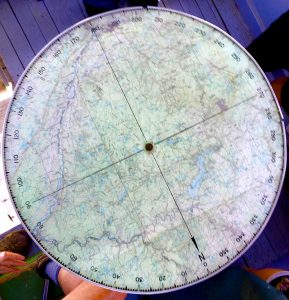
Eva, for the EP NEPA crew…
Day 7 – Rickett’s Glen State Park Hike
Today we hiked at Rickett’s Glen State Park. Accompanying us on the hike were PA Dept of Conservation and Natural Resources Regional Advisor Christine Dettore and Eastern Regional Manager Lorne Possinger.
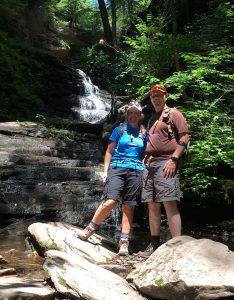
This park is known for its beautiful waterfalls and its long and difficult Falls Trail. 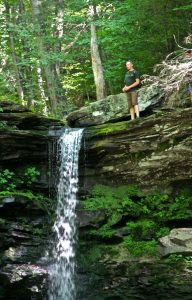 There are also many other amenities at the park such as recreational boating, picnic areas, campsites, and in the winter the park allows climbers to try their hand at ice climbing on their frozen waterfalls.
There are also many other amenities at the park such as recreational boating, picnic areas, campsites, and in the winter the park allows climbers to try their hand at ice climbing on their frozen waterfalls.
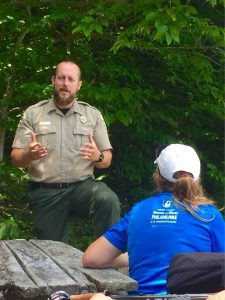
We hiked around four miles and then met up with park manager Ben Stone for a talk about the park and all of the exciting things it has to offer.
He explained to us a little bit how he became the park manager and what he has done in his four years of service as manager at Ricketts Glen State Park.
He also spoke about the process of controlled burns to study forest regrowth. This process involves taking around a 15-foot area and burning everything out to create a barrier from the forest to study its progression.
 Ben also talked about why making stone statues along riverbeds is not a good idea. It removes many different species from their homes and causes disturbances in their ecosystems.
Ben also talked about why making stone statues along riverbeds is not a good idea. It removes many different species from their homes and causes disturbances in their ecosystems.
 After lunch we hopped back on the trail to hike down the other side of the waterfalls. This was about another five miles down steep inclines.
After lunch we hopped back on the trail to hike down the other side of the waterfalls. This was about another five miles down steep inclines.
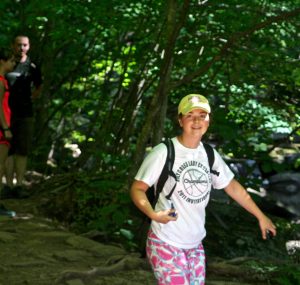
 Eventually we arrived back where we started and decided that what we really needed was some ice cream. So, off we went to Hillside Farms Dairy for some fresh and delicious ice cream to end our excursion.
Eventually we arrived back where we started and decided that what we really needed was some ice cream. So, off we went to Hillside Farms Dairy for some fresh and delicious ice cream to end our excursion.
Ryan, for the EP NEPA crew…
Day 6 – Blakely to Forest City – Bike Ride #2
 Today was the first full-day bike ride. We met at Blakely Park and biked on the Lackawanna River Heritage Trail to Jermyn.
Today was the first full-day bike ride. We met at Blakely Park and biked on the Lackawanna River Heritage Trail to Jermyn.
It is a nicely paved trail that is primarily wooded and shaded and it offers nice views of the calmly flowing river. Thanks to trail signage in Jermyn, we learned that Jermyn was founded in 1874 and is known as “The Birthplace of First Aid in America” because the city offered the nation’s first class on first aid to coal miners.
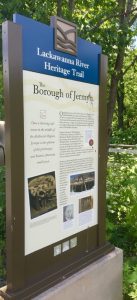 After getting off the trail in Jermyn, we used a variety of roads in Mayfield and Carbondale to get to Forest City,
After getting off the trail in Jermyn, we used a variety of roads in Mayfield and Carbondale to get to Forest City,
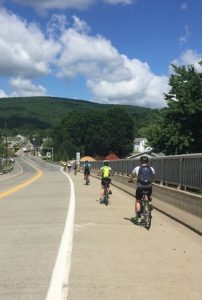 with the last leg of our journey taking us up the relentless incline of Route 171 and past views of the Waymart wind turbines.
with the last leg of our journey taking us up the relentless incline of Route 171 and past views of the Waymart wind turbines.
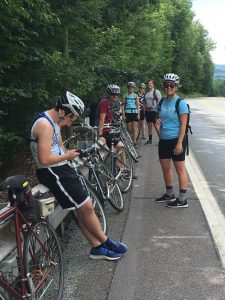 We finally stopped for a “second breakfast” at the Bakery, Café, and Eatery attached to the Citgo station where we had omelets, muffins, pancakes, eggs, homefries, toast, and a lot of chocolate milk!
We finally stopped for a “second breakfast” at the Bakery, Café, and Eatery attached to the Citgo station where we had omelets, muffins, pancakes, eggs, homefries, toast, and a lot of chocolate milk!  The service was great and our waitress was nice enough to take a group photo and send us off with a wave. We retraced our tire tracks back to Blakely, completing the 33 mile ride, but not before thoroughly enjoying
The service was great and our waitress was nice enough to take a group photo and send us off with a wave. We retraced our tire tracks back to Blakely, completing the 33 mile ride, but not before thoroughly enjoying 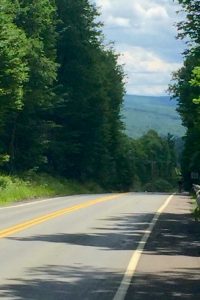
the Rt 171 descent into Carbondale, a lot of roadside Queen Anne’s lace 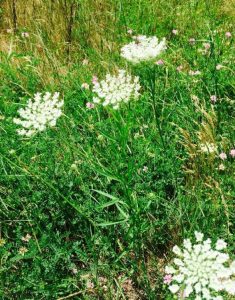 and other wildflowers alongside the road … and of course some photo ops.
and other wildflowers alongside the road … and of course some photo ops.
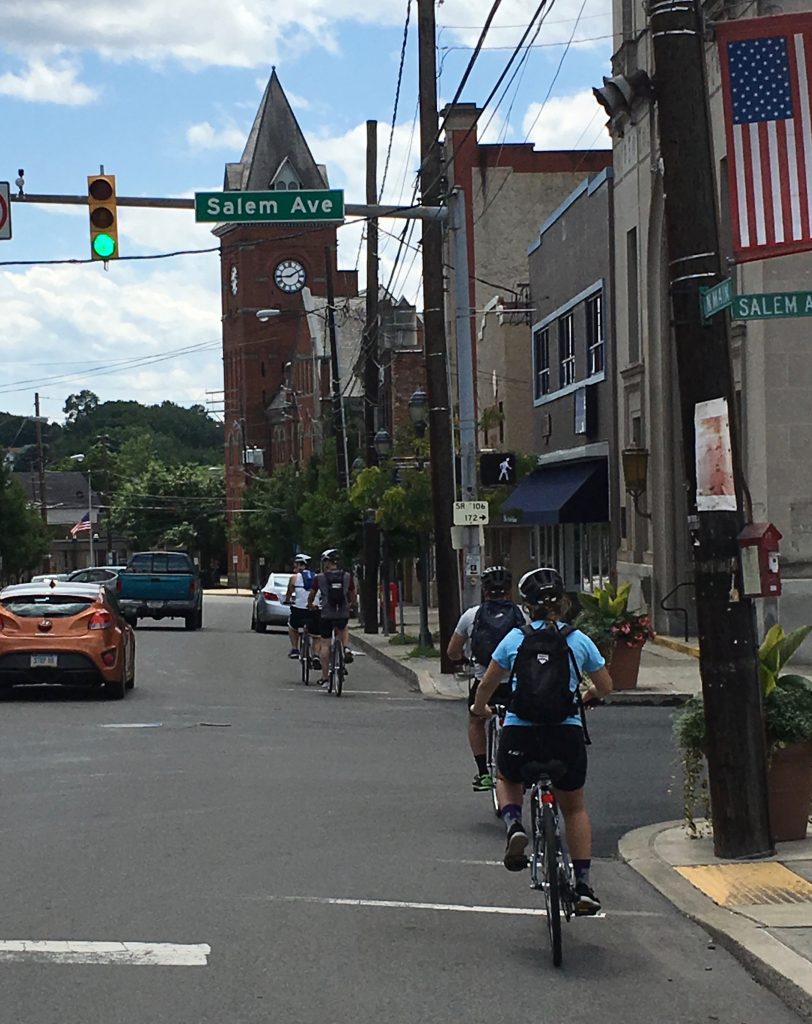
Tara, for the EP NEPA crew…
